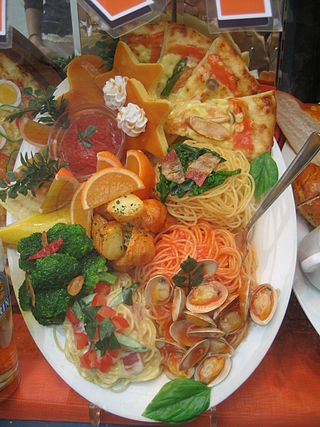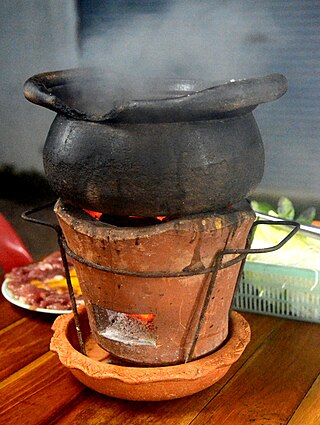A miniature is a small-scale reproduction, or a small version. It may refer to:

Teppanyaki, often called hibachi in the United States and Canada, is a post-World War II style of Japanese cuisine that uses an iron griddle to cook food. The word teppanyaki is derived from teppan, the metal plate on which it is cooked, and yaki, which means grilled, broiled, or pan-fried. In Japan, teppanyaki refers to dishes cooked using a teppan, including steak, shrimp, okonomiyaki, yakisoba, and monjayaki.

A dollhouse or doll's house is a toy house made in miniature. Since the early 20th century dollhouses have primarily been the domain of children, but their collection and crafting is also a hobby for many adults. English-speakers in North America commonly use the term dollhouse, but in the United Kingdom and other English-speaking countries the term is doll's house. They are often built to put dolls in.

Konjac and konnyaku are common names of Amorphophallus konjac, a vegetable species native to Yunnan in southwest China which has an edible corm. It is also known as konjaku, konnyaku potato, devil's tongue, voodoo lily, snake palm, or elephant yam.

In miniature wargaming, players enact simulated battles using scale models called miniature models, which can be anywhere from 2 to 54 mm in height, to represent warriors, vehicles, artillery, buildings, and terrain. These models are colloquially referred to as miniatures or minis.

Tamiya Incorporated is a Japanese manufacturer of plastic model kits, radio-controlled cars, battery and solar powered educational models, sailboat models, acrylic and enamel model paints, and various modeling tools and supplies. The company was founded by Yoshio Tamiya in Shizuoka, Japan, in 1946.

Maltesers are a British confectionery product manufactured by Mars, Incorporated. First sold in the UK in 1937, they were originally aimed at women. They have since been sold in Europe, Australia, New Zealand, Canada, United States and Middle East. The slogan is "The lighter way to enjoy chocolate".

A thickening agent or thickener is a substance which can increase the viscosity of a liquid without substantially changing its other properties. Edible thickeners are commonly used to thicken sauces, soups, and puddings without altering their taste; thickeners are also used in paints, inks, explosives, and cosmetics.

A ball-jointed doll is any doll that is articulated with ball and socket joints. In contemporary usage when referring to modern dolls, and particularly when using the acronyms BJD or ABJD, it usually refers to modern Asian ball-jointed dolls. These are cast in polyurethane synthetic resin, a hard, dense plastic, and the parts strung together with a thick elastic. They are predominantly produced in Japan, South Korea and China. The BJD style has been described as both realistic and influenced by anime. They commonly range in size from about 60 centimetres (24 in) for the larger dolls, 40 cm (15.5 in) for the mini dolls, and down to 10 cm (4 in) for the very smallest BJDs. BJDs are primarily intended for adult collectors and customizers. They are made to be easy to customize, by painting, changing the eyes and wig, and so forth.

An entremet or entremets in Medieval French cuisine referred to dishes served between the courses of the meal, often illusion foods and edible scenic displays. The term additionally referred to performances and entertainments presented between the courses. After the mid-17th century, the term referred to certain types of savory and sweet culinary preparations, and to the stage of the meal in “Classical Service” when they were served. Since the early 20th century, the term has more commonly referred only to the sweet preparations of the entremets stage of the meal.

Fish and fish products are consumed as food all over the world. With other seafoods, they provides the world's prime source of high-quality protein; 14–16 percent of the animal protein consumed worldwide. Over one billion people rely on fish as their primary source of animal protein.

Food models, also known as fake foods, food figurines or "food samples", are scale models or replicas of a food item or dish made from plastic, wax, resin, or a similar inedible material. They are commonly used as mockups in restaurant display windows and shelves in Japan, although other countries like South Korea and China also use such models for similar purposes in restaurants, food boothes, and food carts.
John Armand Mitzewich, more commonly known as "Chef John", is an American chef known for publishing instructional cooking videos on the blog and YouTube channel Food Wishes, with over 1 billion views on his channel.

Nanoblock is a line of construction toys manufactured by Kawada, a toy company based in Tokyo, Japan.

Chim chum is a Southeast Asian street food, popular especially in Thailand. It is traditionally made with chicken or pork and fresh herbs such as galangal, sweet basil, lemongrass and kaffir lime leaves, cooked in a small clay pot on a charcoal stove. It is often served with nam chim.

How To Cook That is an Australian website and YouTube baking channel that provides video recipes on baking and decorating themed cakes, desserts, chocolate creations and other confectionery. Launched as a website in 2011 by founder Ann Reardon, it later gained more than 4 million followers on YouTube, surpassing more than 15.3 million video views per month. The channel has been featured in major publications, including Forbes, The Huffington Post, and The Sydney Morning Herald.

Shopkins were a range of tiny, collectable toys manufactured by Moose Toys. Based on grocery store items, each plastic Shopkin figure has a recognizable face and unique name. They also have special finishes like translucent, glitter, or squishy. The collectable toys also had expanded into lines of clothing, trading cards, and other related merchandise.

Cooking with Dog is a Japanese cooking show web series. It premiered on YouTube on September 9, 2007. The show features a Japanese woman known only as "Chef" who prepares the featured dish of the episode while her toy poodle Francis narrates the process. While Chef speaks in Japanese, Francis narrates the episodes in English, a decision designed to expand the show's audience. Though initially focusing on Japanese cuisine, the show later expanded to include cuisine from other regions. New episodes were uploaded each Friday, before switching to a different release structure in early 2017. Despite the show's popularity and public appearances by Chef, the identities of both Chef and the show's producer are intentionally undisclosed out of privacy concerns.
Tastemade, Inc. is a media company that offers food, travel, and home & design-related programming for online and streaming audiences.



















